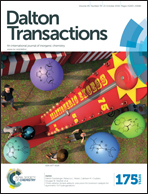Manganese clusters of aromatic oximes: synthesis, structure and magnetic properties†
Abstract
With the aim of tuning the structures by using oxime ligands with different non-coordinating groups, three aromatic oxime ligands were designed by fusing oxime groups (![[double bond, length as m-dash]](https://www.rsc.org/images/entities/char_e001.gif) N–OH) onto different non-coordinating groups. Their reactions with the corresponding Mn(II) salts gave five manganese clusters [MnIII3(μ3-O)(L1)3(DMF)(H2O)3Cl]·2DMF·CH3OH (1), [MnIII3(μ3-O)(L2)3(OAc)(CH3OH)2] (2), [MnIII6(μ3-O)2(L2)6(H2O)(py)7](ClO4)2·py·0.5CH3OH·2H2O (3), [MnIII8O4(L2)8(DMF)4]·DMF·6CH3CN (4), and [MnII4MnIII4O4(L3)12]·3DMF·6H2O (5), in which H2L1, H2L2 and HL3 represent indane-1,2,3-trione-1,2-dioxime, acenaphthenequinone dioxime, and 9,10-phenanthrenedione-9-oxime, respectively. Their structures were determined and studied in detail. 1 and 2 show planar triangular trinuclear MnIII3 structures. 3 has a hexanuclear MnIII6 skeleton formed from two MnIII3 triangular units through inter-trinuclear mutual coordination. 4 and 5 present octanuclear skeletons constructed from planar triangular Mn3O and tetrahedral Mn4O secondary building units, respectively, with different symmetries and different oxidation states of the manganese ions. Their structural studies reveal a significant contribution of the parent rings for fusing oxime groups, different non-coordinating groups and anions to the formation of different cluster skeletons. Their magnetic properties were investigated and simulated, which revealed the presence of dominant antiferromagnetic interactions between the metal ions in these compounds.
N–OH) onto different non-coordinating groups. Their reactions with the corresponding Mn(II) salts gave five manganese clusters [MnIII3(μ3-O)(L1)3(DMF)(H2O)3Cl]·2DMF·CH3OH (1), [MnIII3(μ3-O)(L2)3(OAc)(CH3OH)2] (2), [MnIII6(μ3-O)2(L2)6(H2O)(py)7](ClO4)2·py·0.5CH3OH·2H2O (3), [MnIII8O4(L2)8(DMF)4]·DMF·6CH3CN (4), and [MnII4MnIII4O4(L3)12]·3DMF·6H2O (5), in which H2L1, H2L2 and HL3 represent indane-1,2,3-trione-1,2-dioxime, acenaphthenequinone dioxime, and 9,10-phenanthrenedione-9-oxime, respectively. Their structures were determined and studied in detail. 1 and 2 show planar triangular trinuclear MnIII3 structures. 3 has a hexanuclear MnIII6 skeleton formed from two MnIII3 triangular units through inter-trinuclear mutual coordination. 4 and 5 present octanuclear skeletons constructed from planar triangular Mn3O and tetrahedral Mn4O secondary building units, respectively, with different symmetries and different oxidation states of the manganese ions. Their structural studies reveal a significant contribution of the parent rings for fusing oxime groups, different non-coordinating groups and anions to the formation of different cluster skeletons. Their magnetic properties were investigated and simulated, which revealed the presence of dominant antiferromagnetic interactions between the metal ions in these compounds.


 Please wait while we load your content...
Please wait while we load your content...